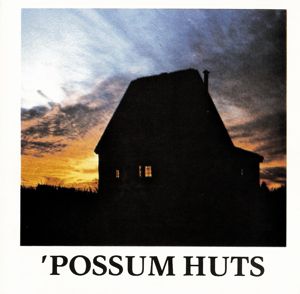'Possum Huts: A Book Review
Smithsonian Magazine, April 1985
What does a maid do when she isn't a-milking? She builds 'possum huts. That is, she does if she is the talented and persistent Helga Tacreiter. When not utterly exhausted, Tacreiter spends her spare moments handcrafting miniature houses - doll houses, you might be tempted to call them - with meticulous interior decor. Now, in this delightful book, she invites us inside her panoply of 'possum huts.

A 'possum hut' for those of us who don't share Tacreiter's intimacy with rural New Jersey and its argot, is in her words "a small crudely built and furnished cabin." There is something appealingly roughhewn, but nothing crude, about Tacreiter's two-foot-high homesteads, as lovingly documented in color photographs by her longtime companion, Walter Hankinson.
Within their latched doors and louvered windows these quaint clapboard cottages are cosily appointed. Behind velvet drapes a platform bed beckons, fitted with a patchwork bedspread and lace-edged embroidered sheets and pillowcases. Light streams through a stained-glass window depicting J. E. Millet's peasant scene The Angelus. Hanging ceramic pots of fern and ivy shade a windowed reading corner. Bread lies on a cutting board in a sunny breakfast nook.
From every aspect the houses and all their holdings appear high, wide and handsome here. The cover shot of a steeply pitched roof outlined against a fiery sunset is redolent of Little House on the Prairie. Just how little these constructions are, however, cannot be discerned from Hankinson's artful choice of camera angles. Only when the photographs show a full-size hand reaching for a thumbnail-size pot or a cow grazing near a fetlock-high cottage is Tacreiter's world put into proper perspective.
Verisimilitude was much on the author's mind, for she dwelt five years in a 'possum hut, a 10-foot-by-12-foot cottage in Amaya Gulch, in California's Santa Cruz Mountains. That shed, built of salvaged glass and packing crates, is pictured in a photograph indistinguishable from those of its pint-sized progeny.
Tacreiter built her first model hut at age 21 in 1973 as a travel advertisement of sorts. "I was infatuated with my home and wanted to invite my sister to come and see it," she recalls. Tacreiter scavenged for wood and pared down her own possessions to make her first miniature. Spoons were shortened, brooms plucked to fashion the first tiny furnishings.
Despite the appealing result, the sister never came and eventually Tacreiter moved on to New Jersey. But she kept on building model 'possum huts. "The feeling of home emerged so strongly from this first model" she writes in meticulous longhand in the book's introduction, "that recapturing this sentiment became the motive to build the second one."
To this and the subsequent 15 huts, Tacreiter began adding features that she desired in her full-scale dream house: colored windows, rocking chairs, extra bookshelves. Each home birth required the same nine-month gestation, heavy labor throughout. But Tacreiter has found a steady source of wood to meet her exacting specifications - "small-grained, brown and grey, and weathered" - clapboards rescued from the country home she and Hankinson have remoded and "fixed up like a 'possum hut inside."
And Tacreiter now has a regular clientele. She published 10,000 copies of 'Possum Huts in response to demand for photographs of her homes at the craft fairs where they are displayed. All of Tacreiter's minihomes have been sold (but for three given to family members) at prices that have climbed from $400 to $2,000 since 1975. She's now completing her first commission: a fantasy castle fit for a queen: Titania, Queen of the Faeries.
If it's anything like these 'possum huts, it will be no small triumph.
